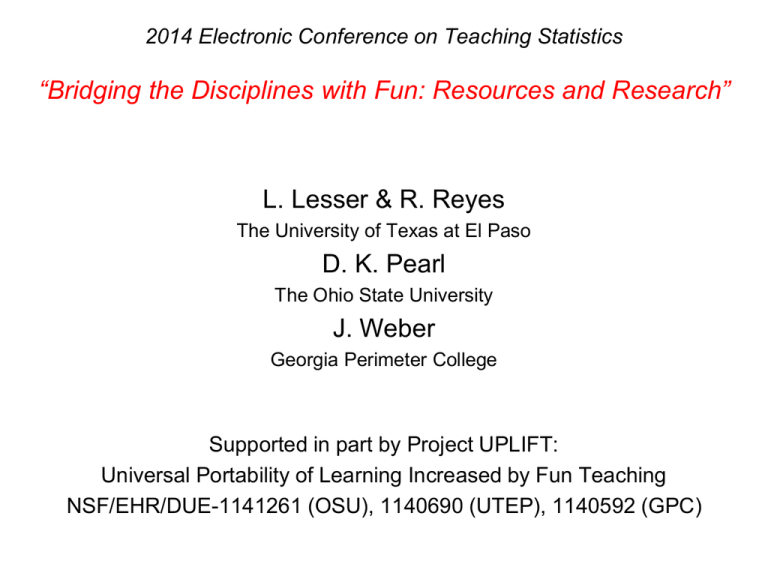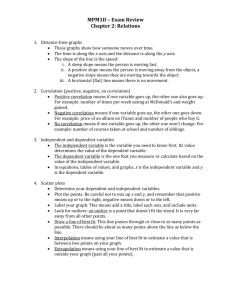Making Statistics Learning Fun! (that's not a factorial sign)
advertisement

2014 Electronic Conference on Teaching Statistics “Bridging the Disciplines with Fun: Resources and Research” L. Lesser & R. Reyes The University of Texas at El Paso D. K. Pearl The Ohio State University J. Weber Georgia Perimeter College Supported in part by Project UPLIFT: Universal Portability of Learning Increased by Fun Teaching NSF/EHR/DUE-1141261 (OSU), 1140690 (UTEP), 1140592 (GPC) “bridging the disciplines…” • Statistics is taken across disciplines • Statistics anxiety occurs across disciplines (e.g., in the humanities, social sciences, and in classes for pre-service elementary school teachers) • Fun spans disciplines Example: “The best lyricists…are using elements of phonetics, linguistics, grammar, semantics, metrics, rhyme, rhythm, poetics, phonology, communications, sociology, and even the psychology of verbal behavior.” (Davis, 1985, p. ix) Background from Lesser et al. in March 2013 J. of Statistics Education and August 2013 JSE webinar • fun connects to GAISE • overview conceptualizations of fun • 20+ modalities of fun listed • sources of statistics fun (e.g., https://causeweb.org/resources/fun/) considerations for use of fun Lesser and Pearl (2008) • Course goal or statistical concept associated with the item • Where used (e.g., in class, on website) • What to do/say/ask before using the fun item to “set it up” • What to do/say/ask after using the fun item let’s illustrate using this cartoon “It’s a Sign: A Connection between Correlation and Slope” (students randomly assigned to include the red part or not) The correlation coefficient r tells us something about the strength and linear relationship of a scatterplot of data. By strength, we mean how tightly the points cluster around the regression line (i.e., the line of best fit). All else being equal, a correlation value of r = .7 (or r = -.7) generally indicates a stronger linear relationship than a value such as r = .3 (or r = -.3). The direction of the relationship has to do with the sign of r. If r > 0, we have positive correlation, which means higher values of Y are associated with higher values of X, and lower values of Y are associated with lower values of X. In other words, X and Y go up and down together. Such a scatterplot would be described best with a line of fit that has a positive slope, and indeed this is always the case: positive correlation happens when the regression line slope is positive. Likewise, r < 0 means negative correlation, with X and Y moving in opposite directions from each other, thus suggesting a line of fit with a negative slope. Finally, a scatterplot with no real linear trend at all (i.e., r = 0) would have a line of fit that is horizontal, which means slope of 0. Whether positive, negative, or zero, the sign of the correlation r is the same as the sign of the slope of the line. Here are lyrics to a song (sung to the tune of the familiar folk tune “Twinkle, Twinkle Little Star” that helped you learn the alphabet) to help you rehearse and permanently acquire this fact in your mind: Correlation Song (lyric © 2013 Lawrence M. Lesser) Are points near a line, or far? What’s the correlation, r? If the fit supports a line, Its slope and r would share the sign. Twinkle, twinkle, you’re a star: Knowing stats will take you far! Click on this MP3 file http://www.causeweb.org/resources/fun/db.php?id=487 so you can hear this 20-second jingle. Now play it one more time (and sing along!). Project UPLIFT: three urban settings Two-Year College University (medium-size) University (large) Region of U.S. Southeast Southwest Midwestern Student population mostly Hispanic general U.S. demographic Type of course Statistical literacy Statistical literacy Statistical literacy Main audience General education Pre-service teachers Arts and humanities Sullivan’s Utts’ Moore & Notz’s Fundamentals of Statistics: Informed Decisions Using Data Seeing Through Statistics Statistics: Concepts & Controversies Desire2Learn Blackboard Desire2Learn Text Learning management system mostly Black student-randomized experiment (fall 2013) (53 from comm. college; 194 from medium-sized university) • All students asked to take pre-tests: SATS (Survey of Attitudes Toward Statistics), SAM (Statistics Anxiety Measure) • Half of the students randomized to have “fun inserts” in content readings accessed via LMS • All students take midterms/finals with embedded multiple-choice items related to the (12-14) content readings • All students asked to take post SATS & SAM POLLING QUESTION #1: Which of these modalities of fun would be most effective in increasing learning? A) cartoons B) poems C) quotes D) songs % Correct with and without Song Inserts Topic Without song With Song Difference Margin of error: down with n down by √n 57.3% 9.1% 61.3% 10.0% 4.0% 0.9% Standard score 62.5% 75.0% 12.5% Correlation & slope 60.2% 73.8% 13.6% Equiprobability bias 40.9% 50.0% 9.1% Multiplicity 36.1% 37.0% 0.9% (med. Univ.) P-value 44.4% 50.0% 5.6% (2-yr.) Total 42.3% 50.0% 7.7% 80% CI on total difference (2.8%, 12.6%) P-value ≈ 0.04 POLLING QUESTION #2: Why do you think songs showed more effectiveness? A) Time with material B) Songs more engaging/active C) More impact on memory D) Other (type your idea in the question box) Why did some fun items appear more effective than others? Spearman’s Rank Correlation of “Effectiveness” with “Activeness” from two independent raters: 0.61 and 0.66 POLLING QUESTION #3: What dimension of the Statistics Anxiety Measure(SAM) should be affected most by fun? A. Anxiety B. Attitude Towards Class C. Fearful Behavior D. Attitude Towards Math E. Performance Post Course avg ± se SAM and Subscale Results (lower is better) Measure/ Subscale Control n = 59 Fun n = 53 Difference SAM total 50.61 ± 1.51 49.08 ± 1.71 1.53 Anxiety 8.32 ± 0.44 7.53 ± 0.45 0.79 Attitude Towards Class 7.17 ± 0.26 6.40 ± 0.28 0.77 Fearful Behavior 12.86 ± 0.42 12.64 ± 0.46 0.22 Attitude Towards Math 12.46 ± 0.73 12.25 ± 0.64 0.21 Performance 9.80 ± 0.36 10.26 ± 0.39 -0.46 POLLING QUESTION #4: Which dimension of the Student Attitudes Toward Statistics(SATS) should be affected most by fun? A. Affect B. Cognitive C. Value D. Difficulty E. Interest Post Course avg ± se SATS Subscale Results (higher is better) Measure/ Subscale Control n = 44 Fun n = 44 Difference Affect 4.11 ± 0.19 4.17 ± 0.21 0.06 Cognitive 4.66 ± 0.16 4.73 ± 0.28 0.06 Value 4.84 ± 0.15 4.46 ± 0.22 -0.36 Difficulty 3.74 ± 0.15 3.75 ± 0.17 -0.01 Interest 3.69 ± 0.21 3.89 ± 0.28 0.20 Effort 6.02 ± 0.20 6.06 ± 0.17 0.04 item-randomized experiment (spring 2014) (≈ 1000 from larger university) • Students take pre- and post- SATS; SAM; and START(Statistical Thinking and Reasoning Test) • Students see 8 content items with each item randomized to include fun insert or not • All students take midterm (3 items) and final (5 items) with embedded multiple-choice items related to the content readings Qualitative Data • Spring 2013 case study: Extreme case sampling (fun-experienced instructor) at medium-sized university, using multiple data sources: field notes or transcripts from 5 observations; six 1-on-1 student interviews; end-of-course ratings and narrative comments from 21 students • Fall 2013 data: eight 1-on-1 student interviews from community college Representative findings from the qualitative data • Contextualizing statistics problems in relatable, real-world examples helped students either understand the concept and/or remember the context of the content taught • A fun/humorous approach by the instructor to teaching statistics made the content memorable and/or tolerable for those who experienced anxiety over taking statistics • Almost all students were appreciative (and the exceptions were just indifferent) of instructors who made an effort to integrate fun/humor, real-world examples, and/or materials during instruction to teach concepts BACKGROUND FOR POLLING QUESTION #5: One interviewee provided the following response to this question: What do you think of the use of cartoon, jokes, songs, and games by the instructor? “I like them because I’ve been used to mathematics classes where it’s just strict. It’s like, if you learn the subject that’s all you can talk about in class. It’s nice to have just …getting off topic pretty much and kind of just letting loose for a little. It’s still related to the subject and you don’t even realize it, it’s just related to the subject but somehow it eases the tension that you might think of is associated with any math course.” “I like them because I’ve been used to mathematics classes where it’s just strict. It’s like, if you learn the subject that’s all you can talk about in class. It’s nice to have just …getting off topic pretty much and kind of just letting loose for a little. It’s still related to the subject and you don’t even realize it, it’s just related to the subject but somehow it eases the tension that you might think of is associated with any math course.” POLLING QUESTION #5: Which best describes how this student views in-class fun? a) distracting b) engaging but irrelevant c) engaging and relevant d) relieves anxiety e) other (type your idea in the question box) BACKGROUND FOR POLLING QUESTION #6: How would you interpret the following from another student in the case study, in response to a question on the use of fun items, such as cartoons, songs, games, etc.?: “…it lightens the mood and it’s more than just numbers being pounded into your head for an hour and a half straight. I’ve got other professors that do that and it’s just, frustrating after a while.” “…it lightens the mood and it’s more than just numbers being pounded into your head for an hour and a half straight. I’ve got other professors that do that and it’s just frustrating after a while.” POLLING QUESTION #6: What does this quote say about the student’s desire for the classroom atmosphere? a) Students find STEM courses too boring to promote learning b) Students want to feel engaged regardless of ties to content c) Students want to feel a connection to the instructor d) Students just want to have fun e) other (type your idea in the question box) Key References STATISTICS FUN: https://causeweb.org/resources/fun/ Lesser, L. M.; Wall, A.; Carver, R.; Pearl, D. K.; Martin, N.; Kuiper, S.; Posner, M. A.; Erickson, P.; Liao, S.M.; Albert, J., & Weber, J. J. (2013). Using fun in the statistics classroom: An exploratory study of college instructors’ hesitations and motivations. Journal of Statistics Education, 21(1), 1-33. (also, see www.causeweb.org/webinar/jse/2013-08) Lesser, L. & Pearl, D. (2008). Functional fun in statistics teaching: Resources, research, and recommendations. Journal of Statistics Education, 16(3), 1-11. AN INSPIRATION FOR THE EXPERIMENTAL DESIGN: Garner, R. L. (2006). Humor in pedagogy: How ha-ha can lead to aha! College Teaching, 54(1), 177-180. INSTRUMENTS (SAM and SATS): Earp, M.A. (2007). Development and validation of the Statistics Anxiety Measure. University of Denver. http://iase-web.org/documents/dissertations/07.Earp.Dissertation.pdf Schau, C., Stevens, J., Dauphinee, T. L., & Del Vecchio, A. (1995). The development and validation of the Survey of Attitudes Toward Statistics. Educational and Psychological Measurement, 55(5), 868-875. QUESTIONS? • Type questions you have now in the chat window. • If you think of questions later, please attend the “Bridging the Disciplines” eCOTS panel set for Friday 3:45pm EST or email us: dkp@stat.osu.edu, Lesser@utep.edu, John.Weber@gpc.edu, Rreyes9@utep.edu THANKS FOR YOUR INTEREST!




